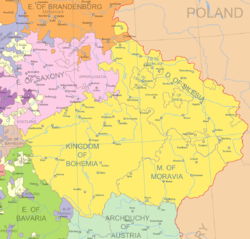War of the Austrian Succession
The War of the Austrian Succession (1740–1748) involved most countries in Europe and was fought over Archduchess Maria Theresa's succession to the Habsburg monarchy. The war included other conflicts such as King George's War in British North America, the War of Jenkins' Ear in South America and the Caribbean Sea (which formally began on 23 October 1739), the First Carnatic War in India, the Jacobite rising of 1745 in Scotland and England, and the First and the Second Silesian Wars in Central Europe.
Maria Theresa was not allowed to succeed to the various crowns of her father, Charles VI, because Salic law would not let a woman inherit them. That gave an opportunity for France and Prussia, which were joined by Bavaria, to challenge the Habsburgs' power. Maria Theresa was supported by Great Britain, the Dutch Republic, Sardinia, and Saxony.
Spain had been at war with Britain over colonies and trade since 1739 to re-establish its influence in Northern Italy, which Austria had taken during the War of the Spanish Succession in the early 18th century.
The war ended with the Treaty of Aix-la-Chapelle in 1748. Maria Theresa was confirmed as Archduchess of Austria and Queen of Hungary, but Prussia kept control of Silesia. The peace did not last, however, because Maria Theresa wanted to recapture Silesia and political upheaval occurred in Europe. Those factors led to the Seven Years' War (1756–1763).
War Of The Austrian Succession Media
Maria Theresa, whose succession was the proximate cause of the war
Lands of the Bohemian Crown; in 1742, most of Silesia was ceded to Prussia
Charles Emmanuel III of Sardinia, who entered the war by the September Treaty of Worms
Frederick the Great, by Wilhelm Camphausen; his position at the end of 1744 was extremely precarious
Maria Theresa's husband, Francis I, elected Holy Roman Emperor on 13 September 1745
Victory at Fontenoy in May 1745 re-established French confidence
Philip V of Spain's family by Louis-Michel van Loo
The Prince of Conti by Alexis Simon Belle









